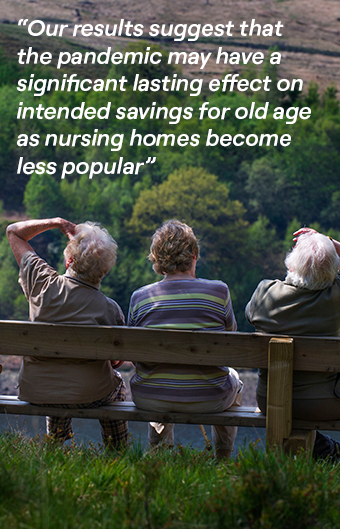Our collective failure to protect the most vulnerable from epidemics was cruelly exposed during the Covid-19 crisis, as the elderly were often hardest hit by mortality rates and debilitating living conditions. The urgent need to identify the best policies to respond to the challenges of pandemic risks and aging societies – and their potential to combine with devastating effect – has been driving innovative research at TSE Health Center since its launch in 2021. As part of such efforts, Philippe De Donder joined researchers in Canada to investigate the impact of Covid-19 outbreaks in nursing homes on our ideas and decisions about old-age care.
What sparked your interest in attitudes toward nursing homes in the wake of the pandemic?
As in many countries, the pandemic shed light on the precarious sanitary conditions experienced by many elderly Canadians, with extensive media coverage of the dramatic consequences of Covid in nursing homes. In the first wave, from March to August 2020, more than 80% of Canada’s Covid deaths were reported in nursing and seniors’ homes. The pandemic also focused minds on how nursing homes are managed in normal times, their lack of staff, and the consequences of a pandemic on the quality of life for nursing-home residents.
By increasing Canadians’ awareness about their long-term care (LTC) needs, we suspected that the pandemic may have durably affected their preferences regarding future LTC solutions. In particular, rising aversion to nursing-home care may have led policymakers and the population in general to think about alternative solutions such as receiving LTC at home. As home care is much more expensive than public nursing home care, at least if dependents cannot rely on informal care from friends and family, shifting preferences are likely to have major implications for savings and long-term care policies.
How do you highlight the potential mechanisms behind changing preferences?
We consider two of the pandemic’s potential long-term implications. First, more people may believe in the possibility of a recurring pandemic and that a nursing home provides little protection against such risks. Second, the Covid-19 crisis might have worsened individuals’ view on nursing-home care even in the absence of a pandemic, as they received more negative information about the quality of nursing-home care.
 We develop a theoretical model that allows us to form sharp predictions on the impact of the pandemic on intended savings as well as on support for a specific LTC policy. Following a pandemic, our model predicts that a higher proportion of households prefer to use home care – even though it is more costly than nursing-home care – and choose to save more to finance it. We also show that post-pandemic support for a home-care subsidy, financed by taxation, is likely to increase across the board.
We develop a theoretical model that allows us to form sharp predictions on the impact of the pandemic on intended savings as well as on support for a specific LTC policy. Following a pandemic, our model predicts that a higher proportion of households prefer to use home care – even though it is more costly than nursing-home care – and choose to save more to finance it. We also show that post-pandemic support for a home-care subsidy, financed by taxation, is likely to increase across the board.
What are your key empirical findings?
In a large survey of Canadians aged 50 to 69, we asked respondents about how their LTC preferences, saving behavior, and preferences for public policies were affected by the recent Covid pandemic. The results provide strong evidence in support of our theoretical predictions.
We find a widespread increase in nursing-home aversion following the pandemic: more than 72% of the sample are less inclined to enter a nursing home and a similar proportion have a worse view of nursing-home health risks. At the same time, about a quarter report that they plan to save more for old age because of Covid, and the vast majority of these respondents say that their planned increase in savings is intended to avoid entering a nursing home. Overall, our results suggest that the pandemic may have a significant lasting effect on intended savings for old age as nursing homes become less popular.
Our results suggest that home-care subsidies could enjoy broad electoral support: 70% of our sample either “very much agree” or “agree” with such a policy. We find strong evidence that this post-pandemic increase in support for a home-care subsidy is driven by increased nursing-home aversion.
How should policymakers respond?
Developing adequate LTC policies regarding the type of care provision and financing solutions is crucial. In every developed country, populations are aging, so that the fraction of people with very specific health needs is growing. In the total OECD population, the proportion of people over 80 is expected to grow from 4% in 2010 to 10% in 2050.  Just as the pandemic pushed many people to reconsider the attractiveness of home versus nursing-home care, and to adapt their saving plans accordingly, policymakers will need to develop LTC policies that are better suited to the new normal. Policy solutions include the construction of new nursing homes, better training for LTC workers, and making home care more affordable. Our results underline the importance of designing appropriate policies to provide affordable alternatives to nursing homes – such as subsidies and tax exemptions – and that these may have strong support from the public.
Just as the pandemic pushed many people to reconsider the attractiveness of home versus nursing-home care, and to adapt their saving plans accordingly, policymakers will need to develop LTC policies that are better suited to the new normal. Policy solutions include the construction of new nursing homes, better training for LTC workers, and making home care more affordable. Our results underline the importance of designing appropriate policies to provide affordable alternatives to nursing homes – such as subsidies and tax exemptions – and that these may have strong support from the public.
FURTHER READING
Philippe leads the Center’s ‘Innovation in Health’ program. His research in public economics, regulation and health economics, including ‘Nursing home aversion post-pandemic: Implications for savings and long-term care policy’, is available to read on the TSE website.
Article published in TSE Reflect, March 2023




